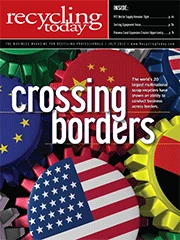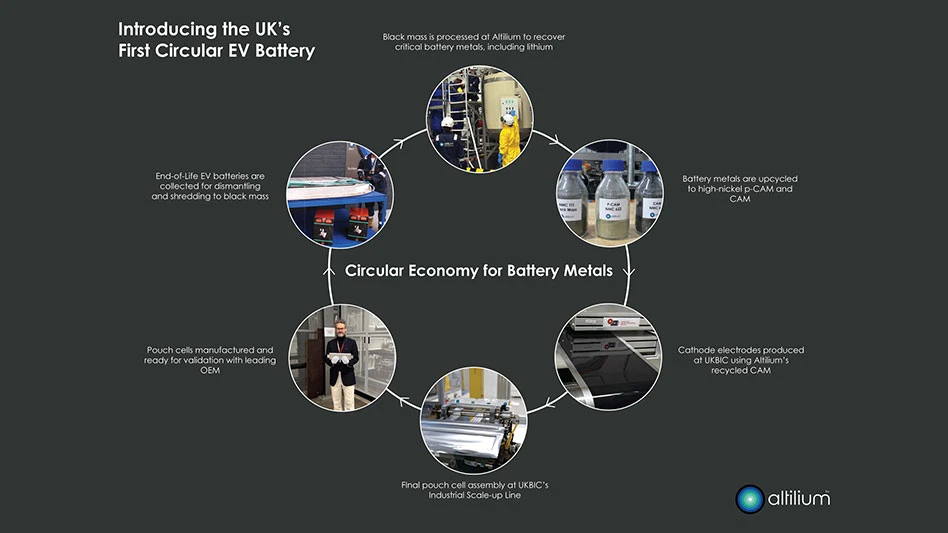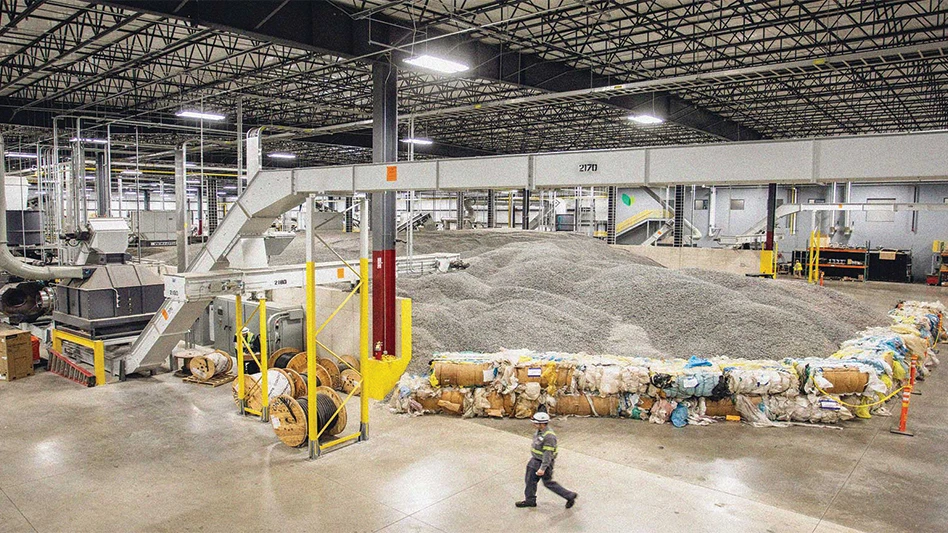 In the recycling industry, conventions are the harbinger of spring. Recyclers from around the world had no shortage of events to choose from this year, including WasteExpo, IFAT Entsorga and the Bureau of International Recycling’s (BIR’s) World Recycling Convention & Exhibition.
In the recycling industry, conventions are the harbinger of spring. Recyclers from around the world had no shortage of events to choose from this year, including WasteExpo, IFAT Entsorga and the Bureau of International Recycling’s (BIR’s) World Recycling Convention & Exhibition.
Both WasteExpo and IFAT Entsorga boasted growth in 2012. IFAT Entsorga, which was in Munich from May 5-9, claimed the participation of some 125,000 visitors and 3,000 exhibitors this year, while WasteExpo, which was April 30 to May 1 in Las Vegas, reported nearly 1,200 attendees and more than 550 exhibiting companies. The BIR World Recycling Convention also exceeded the attendance expectations of its organizers.
Waste Expo
According to Penton Media, the organizers of WasteExpo 2012, the event saw a record number of exhibitors and a 20 percent increase in registration this year, attracting attendees from North America as well as from Australia, Brazil, Bulgaria, Cameroon, China, Columbia, Croatia, France, Ghana, Greece, India, Italy, Romania, Saudi Arabia, Singapore and Ukraine.
Rita Ugianskis, managing director of Penton Media’s Waste Industry Group, says WasteExpo “has been the waste and recycling industry’s premier forum for one-of-a-kind education, connecting with over 11,000 peers and finding industry solutions for over 40 years, and this year was no exception. We are delighted that our attendees and exhibitors had such a great experience this year because that is our true gauge of success. We are also pleased that overall registration, international and domestic attendance and exhibit hall sales were all up this year as well. This optimistic outlook certainly has us looking forward to another strong event in New Orleans in 2013.”
The conference featured more than 40 sessions on a variety of topics organized by the Environmental Industry Associations. Topics included “PAYT (Pay as You Throw)/Recycle & Save—Moving Diversion Forward Fast” and “Acquisition Due Diligence & Transition Plans.” Attendees of the WasteExpo 2012 also had the opportunity to learn about the factors driving C&D (construction and demolition) recycling during a session titled, “Construction & Demolition Debris: Processing Trends.”
Kenny Lark, director of strategic business for Waste Management’s (WM’s) Construction Solutions segment discussed the strides the Houston-based company has made in this area during the past several years. He told attendees that WM operates 35 C&D processing facilities.
In 2009, WM formed its Construction Solutions division. The company has increased its C&D processing capacity by 233 percent in the last three years Lark said. “Lack of consistent and viable end-market solutions” is an example he gave as a barrier to C&D recycling.
Andy Lake of Armstrong World Industries, Lancaster, Pa., urged attendees to participate in the fourth comment period for Leadership in Energy and Environmental Design (LEED) 2012. More information about LEED 2012 is available at www.usgbc.org.
The company, which has operated a ceiling tile recycling program for the past 12 years, also has begun accepting certain types of its flooring for recycling. Lake said that it is the companies that are able to take in these additional materials that will be able to increase their recycling rates and stand out to customers. “Those people who are able to distinguish themselves are getting the work,” he said.
Bill Turley, executive director of the Illinois-based Construction Materials Recycling Association (CMRA) discussed how the organization was addressing what he called the problem of “sham recycling” through a certification process conducted by a third party. The third-party organization created to administer Certification of the Real Rates (CORR) is the Institute for Certification of Sustainable Recyclers (ICSR). The administrator for the certification program is J.W. Spear. The certification will validate a facility’s recycling rate.
“We are there to measure what is getting recycled,” Turley said. Information about the certification program is available at www.recyclingcertification.org.
WasteExpo 2013 is scheduled for May 20-23 in New Orleans. More information is available at www.wasteexpo.com.
IFAT Entsorga
Messe München International, the organizer of IFAT Entsorga 2012, reports that some 16,000 delegates participated in the conference program portion of the show, which included nearly 320 presentations and discussions. Topics included mega cities, water management, phosphorous recycling from sewage sludge, the Life-Cycle Resource Management Act and waste to energy.
A poll conducted by TNS Infratest indicates that 97 percent of visitors to the events program scored it “good” to “excellent,” Meese München reports.
Otto Schaaf, president of the German Association for Water, Wastewater and Waste, says, “At IFAT Entsorga what impresses most is the breadth and depth of the products and services on display and the comprehensive international coverage.” The exhibition hall offers a broad display of the latest technology, he adds.
“IFAT Entsorga is also a meeting place for top managers, and large numbers of them come to this event,” Schaaf says.
The next IFAT Entsorga trade fair and conference is scheduled for May 5-9, 2014, in Munich. The five-day event is considered the largest conference focusing on water, sewage, waste and raw materials management.
BIR World Recycling Convention
The 2012 BIR World Recycling Convention attracted roughly 1,300 attendees from some 60 countries to Rome from May 29 to June 1. At the conference’s general assembly session, Thursday, May 31, BIR President Björn Grufman of Sweden-based Metallvärden AB said 2011 was the year in which the recycling industry achieved “a great success,” referencing the European Union’s End-of-Waste legislation.
“After decades of lobbying by the European BIR daughter associations EFR (European Ferrous Recovery and Recycling Federation) and Eurometrec, we were finally given the possibility within Europe of extracting our end products from the waste regime,” Grufman said. “End-of-waste criteria have already been introduced for iron, steel and aluminum scrap, and the industry’s efforts to secure a similar result for copper and recovered paper are well under way.”
According to Grufman, the global recycling industry “must be allowed the scope to develop—and with a healthy measure of profitability—in order to continue to make its important contribution to the sustainable society of our future.”
While 2011 may have been a good year for the industry, a number of serious issues are causing rough weather for scrap processors and traders in 2012, but an underlying demand for secondary commodities remains a strong ray of sunshine.
In his address to the conference delegates, Grufman called 2011 “the year in which the world realized that you cannot keep borrowing money forever; someday you must pay it back.”
He pointed to several recycling industry success stories in the past 12 months.
The resulting austerity measures in Europe and other parts of the world have kept economic growth in check, but nonetheless “recycling markets showed positive trends” in 2011, Grufman said.
John Authers, senior investment analyst at The Financial Times, London, delivered the keynote address May 31. Authers pointed to Spain as a “pivotal country” in the current euro-zone crisis, suggesting that it is “too big to be allowed to leave the euro [zone]” and potentially “too big for current rescue funds” to cover all of its debts.
As the BIR convention was taking place, the euro was losing value against the dollar, and Authers remarked that in his view this would be a positive trend if it continued. While a return to greater parity between the dollar and the euro might adversely affect the U.S. and some emerging markets, the alternative—a disorderly collapse of the Euro—would hit most economies (and especially Europe’s) even harder.
Even with a stronger dollar, Authers said he was “tentatively optimistic” about the U.S. economy.
Concerning the recovered paper segment, shippers have export markets, but freight rates are making some of them difficult to reach.
Attendees of the Paper Division meeting at the 2012 BIR World Recycling Convention heard encouraging news about global demand but discouraging words about freight rates.
Paper Division President Ranjit Baxi of J&H Sales International, based in London, said as of late May increasing freight rates in Europe were “making exports very difficult.”
European economic woes are a part of the problem, as there are fewer containers arriving in Europe. Freight increases in North America have not been nearly as high as those experienced by European shippers, panel members reported.
Ekrem Demircioglu of Turkey-based Tüdam, however, reported that in 2012’s second quarter, “the fall in demand [from the] Far East caused a drop in prices” in Turkey, while at the same time “the spring local collection rates increased.”
While demand from mills in China may advance and retreat in some markets, Baxi provided figures showing that the nation continues to consume imported scrap paper at an impressive level.
In the first quarter of 2012, China imported 3.4 million tons of recovered fiber from North America and nearly 2.4 million tons from Europe. Those figures exceed the pre-economic crisis levels of the first quarter of 2007, when China brought in 2.66 million tons from North America and 1.9 million tons from Europe.
The 2013 BIR World Recycling Convention & Exhibition will be May 26-29 in Shanghai.
The editorial staff of Recycling Today contributed to this feature.

Explore the July 2012 Issue
Check out more from this issue and find your next story to read.
Latest from Recycling Today
- Returpack reports increased DRS activity in Sweden
- Trade groups align against European export restrictions
- Construction, auto sectors show mixed signals
- Politics in Turkey threaten recycled steel outlet
- Toppoint Holdings expands chassis fleet
- Lego creates miniature tire recycling market
- Lux Research webinar examines chemical recycling timetables
- Plastics producer tracks pulse of wire recycling market





